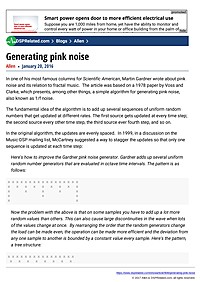
Generating pink noise
In one of his most famous columns for Scientific American, Martin Gardner wrote about pink noise and its relation to fractal music. The article was based on a 1978 paper by Voss and Clarke, which presents, among other things, a simple...
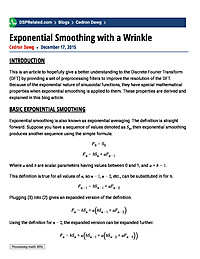
Exponential Smoothing with a Wrinkle
Introduction This is an article to hopefully give a better understanding to the Discrete Fourier Transform (DFT) by providing a set of preprocessing filters to improve the resolution of the DFT. Because of the exponential nature of...

Margin Call: Fermi Problems, Highway Horrors, Black Swans, and Why You Should Worry About When You Should Worry
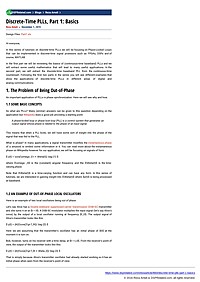
Discrete-Time PLLs, Part 1: Basics
In this series of tutorials on discrete-time PLLs we will be focusing on Phase-Locked Loops that can be implemented in discrete-time signal proessors such as FPGAs, DSPs and of course, MATLAB.
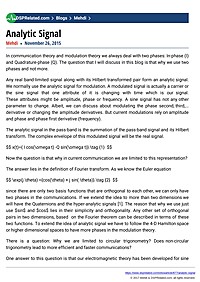
Analytic Signal
In communication theory and modulation theory we always deal with two phases: In-phase (I) and Quadrature-phase (Q). The question that I will discuss in this blog is that why we use two phases and not more.

Blogging Tutorial
This article will be updated on a regular basis based on your questions and feedback. Creating a new blog post Make sure your are logged in Click on 'Create new blog post' Although the online editor works pretty well and...
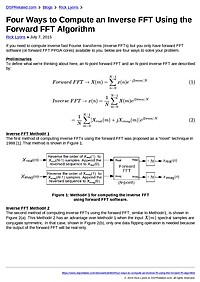
Four Ways to Compute an Inverse FFT Using the Forward FFT Algorithm
If you need to compute inverse fast Fourier transforms (inverse FFTs) but you only have forward FFT software (or forward FFT FPGA cores) available to you, below are four ways to solve your problem. Preliminaries To define what we're...
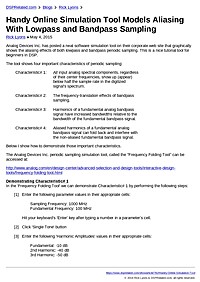
Handy Online Simulation Tool Models Aliasing With Lowpass and Bandpass Sampling
Analog Devices Inc. has posted a neat software simulation tool on their corporate web site that graphically shows the aliasing effects of both lowpass and bandpass periodic sampling. This is a nice tutorial tool for beginners in DSP. The...
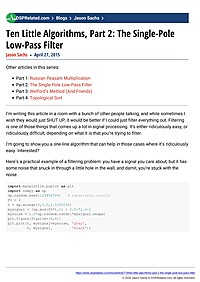
Ten Little Algorithms, Part 2: The Single-Pole Low-Pass Filter
Other articles in this series: Part 1: Russian Peasant Multiplication Part 2: The Single-Pole Low-Pass Filter Part 3: Welford’s Method (And Friends) Part 4: Topological Sort I’m writing this article in a room with a bunch of...
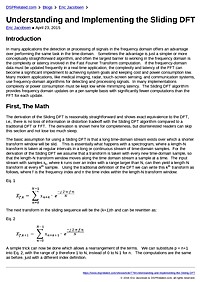
Understanding and Implementing the Sliding DFT
Introduction In many applications the detection or processing of signals in the frequency domain offers an advantage over performing the same task in the time-domain. Sometimes the advantage is just a simpler or more conceptually...
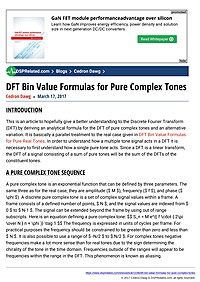
DFT Bin Value Formulas for Pure Complex Tones
Introduction This is an article to hopefully give a better understanding to the Discrete Fourier Transform (DFT) by deriving an analytical formula for the DFT of pure complex tones and an alternative variation. It is basically a parallel...
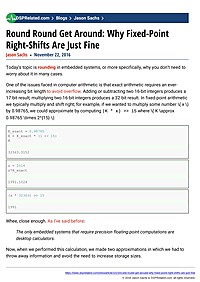
Round Round Get Around: Why Fixed-Point Right-Shifts Are Just Fine
Today’s topic is rounding in embedded systems, or more specifically, why you don’t need to worry about it in many cases.One of the issues faced in computer arithmetic is that exact arithmetic requires an ever-increasing bit length to...
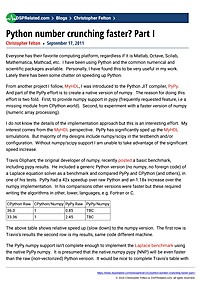
Python number crunching faster? Part I
Everyone has their favorite computing platform, regardless if it is Matlab, Octave, Scilab, Mathematica, Mathcad, etc. I have been using Python and the common numerical and scientific packages available. Personally, I have found this...
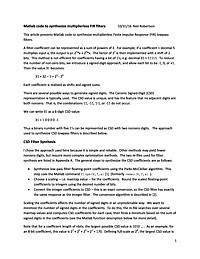
Matlab Code to Synthesize Multiplierless FIR Filters
This article presents Matlab code to synthesize multiplierless Finite Impulse Response (FIR) lowpass filters. A filter coefficient can be represented as a sum of powers of 2. For example, if a coefficient = decimal 5 multiplies input x,...
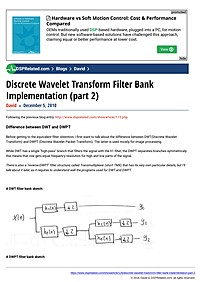
Discrete Wavelet Transform Filter Bank Implementation (part 2)
Following the previous blog entry: http://www.dsprelated.com/showarticle/115.php Difference between DWT and DWPT Before getting to the equivalent filter obtention, I first want to talk about the difference between DWT(Discrete Wavelet...

Ten Little Algorithms, Part 2: The Single-Pole Low-Pass Filter
Other articles in this series: Part 1: Russian Peasant Multiplication Part 2: The Single-Pole Low-Pass Filter Part 3: Welford’s Method (And Friends) Part 4: Topological Sort I’m writing this article in a room with a bunch of...
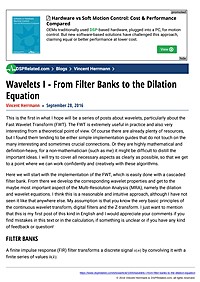
Wavelets I - From Filter Banks to the Dilation Equation
This is the first in what I hope will be a series of posts about wavelets, particularly about the Fast Wavelet Transform (FWT). The FWT is extremely useful in practice and also very interesting from a theoretical point of view. Of course there...
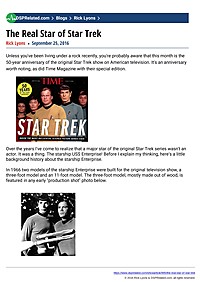
The Real Star of Star Trek
Unless you've been living under a rock recently, you're probably aware that this month is the 50-year anniversary of the original Star Trek show on American television. It's an anniversary worth noting, as did Time Magazine with their special...
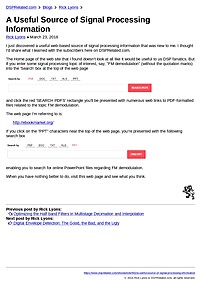
A Useful Source of Signal Processing Information
I just discovered a useful web-based source of signal processing information that was new to me. I thought I'd share what I learned with the subscribers here on DSPRelated.com. The Home page of the web site that I found doesn't look at...

Signed serial-/parallel multiplication
Keywords: Binary signed multiplication implementation, RTL, Verilog, algorithm Summary A detailed discussion of bit-level trickstery in signed-signed multiplication Algorithm based on Wikipedia example Includes a Verilog implementation with...


















